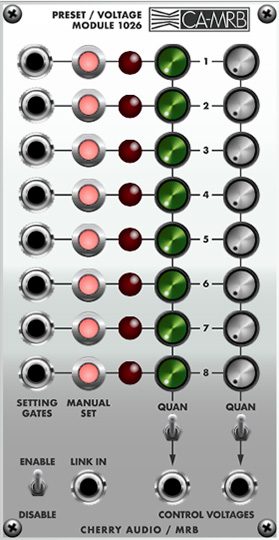
The 1026 Preset Voltage module is similar to a conventional dual eight-step sequencer, but instead of playing consecutively through its steps, it has buttons and CV inputs allowing random selection of any stage. It contains no onboard clocking or transport controls. With that that said, its Link In jack allows CV control of stages, allowing sequential step playback - more on this later.
It's useful for making slow changes, for example, changing the key center of another sequencer (such as the 1027 Clocked Sequential Control) but it can run at any speed, in any order depending upon the CV sources it's paired with.
Inputs, Outputs, and Controls
Most of the controls are repeated in each of the eight stages; note that the panel labels are beneath the last stage at the bottom. Unlike Coachella, only one stage can be active at any time.
Setting Gates inputs- Sending a +5V trigger or gate signal to these selects the stage.
Setting Gates Enable switch- The toggle beneath the Settings Gates jacks enables and disables CV reception. The Manual Set buttons still work when disabled.
Manual Set- Clicking the button selects the stage.
Stage active lamp- Glows to indicate the currently selected stage.
Control Voltages knobs- Each vertical column of knobs sends a separate voltages to its corresponding output jack, depending on which stage is currently active. These can be set from 0 to +5V.
Link In- Not to be confused with the job networking web site that nobody actually uses, the Link In jack uses a dynamic CV to enable synchronization between modules. Specifically, the 1027 Clocked Sequential Controller module is intended to be the master clock, and its Link Out jack should be patched to one or more 1026 Preset Voltage and/or 1050 Mix Sequencer modules. The Enable switch makes the Link input active.
The Link In jack can also be slightly misused for step control with positive-polarity LFO waves - the positive polarity saw wave from any of the 1004 or 1023 oscillators is perfect for this. The idea is to use waves that change voltage over their duration, so square waves won't work well (they'll simply alternate between two positions). Adding an attenuator module (such as the Attenuverter) between the LFO and the Link In jack allows control of the number of steps as well.
Quantize switches- In the down position, the control knobs can be freely set to any voltage between 0 to +5V. If the CV outs are used to control oscillators, it can make tuning melodies difficult. When engaged, the CV knobs move in 1/12V steps , which equates to semitones.
Output jacks- The jacks at the bottom of each knob column outputs the voltage for the currently active stage.